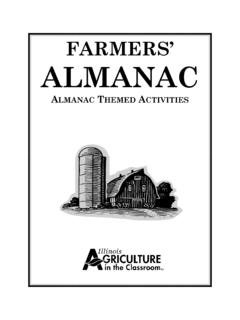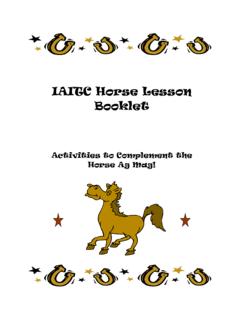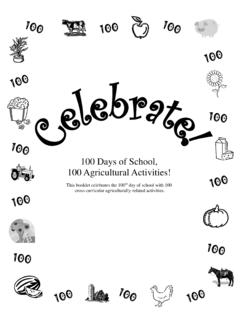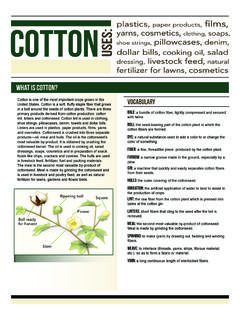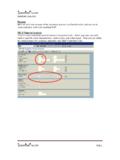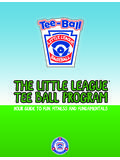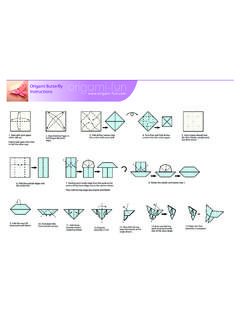Transcription of After School Agriculture - Illinois AITC
1 Illinois Agriculture in the Classroom After School Agriculture Activities and Lessons to Enhance your After School Program Grade Levels k-3 2 Illinois Agriculture in the Classroom The activities in this IAITC booklet have been designed for Af-ter School Programs as a way to incorporate Agriculture into their daily activities. This booklet has been designed with the Kindergarten through 3rd grade student in mind. Lessons in this booklet focus on Dairy, Specialty Crops, Beef, Pork and Pizza. These Ag Mag topics can be obtained from your County Ag Literacy Coordinator, which can be found on our website: The lessons have been structured to fit a five day schedule for each agricultural category. Lessons throughout the week will include a Reading/Vocabulary Activity, a Hands-On Activity, a Sci-ence Activity, a Math Activity, and a Nutrition Activity. Our suggestion is to start with the Reading/Vocabulary Les-son which includes a book.
2 Every lesson thereafter will relate to the book and the agricultural category. Beyond day 1, the lesson order is up to the After School Program Coordinator. Our hope is that students who take part in the After School Program will learn about Agriculture and the world around them while having fun too. 3 Illinois Agriculture in the Classroom DAIRY Reading/Vocabulary Clarabelle: Making Milk and So Much More by Cris Peterson Hands-on Activity Moo Masks Science Milk and You Webquest Math ISAT Activity - Dairy 4th Grade Nutrition Better Butter 4 Illinois Agriculture in the Classroom Moo Masks Grade Level: K-3 Objectives: Students will demonstrate an ability to identify types of cattle based on markings. Illinois Learning Standards: , , , Assessment Framework: , , , , , Materials Needed: IAITC Dairy Ag Mag 1 Large dinner plate 2 Small dessert plates String Glue or Staples Crayons, markers, or colored pencils IAITC Dairy Ag Mag Activity Outline: 1.
3 Have the students cut one dessert plate in half. 2. Have the students staple or glue the other dessert plate behind the large dinner plate. They should draw eyes on the dessert plate and a mouth on the dinner plate. 3. Next use the dessert plate that was cut in half to make two ears that are glued or stapled to the top of the dessert plate with the eyes. 4. Have the students use the writing utensils to color the cow with black and white spots. 5. Have the students add an ear tag to their mask, using their birth date in numer-als. 6. Attach string to the side of the mask to allow it to wrap around their heads. 7. Let the students wear their masks while they read the Dairy Ag Mag from your County Farm Bureau . 5 Illinois Agriculture in the Classroom Milk and You Webquest Introduction You probably drink milk everyday. Have you ever thought about where it comes from? We all know that milk comes from a cow, but how does the milk get into the carton you drink at home or at School ?
4 Task Your task is to investigate how milk travels from the cow to your home or your School . You will cre-ate a milk storyboard and a classroom survey of milk drinkers. Process Activity 1: Milk Storyboard: From the Cow to the Carton 1. Read The Story of Milk as your teacher reads it aloud. 2. Visit the following websites to create a storyboard that shows how milk gets from the cow to the carton. Your storyboard should contain at least five events. Each box should contain both pictures and words. Storyboard Page How to Create a Storyboard 3. Visit this webpage . Move your mouse around the picture and you will see what it looks like in a barn where cows are being milked. How often are cows milked? How many days a year are cows milked? How many days are there in a year? Activity 2: Classroom Milk Survey 1. For four days (Monday-Thursday), keep track of how many cartons of milk the students in your class drink each day at School .
5 Record how many cartons were white milk and how many were chocolate milk. 2. At the end of the week, put the results in a graph using this website. 3. Answer the following questions about your class: Classroom Survey Results 6 Illinois Agriculture in the Classroom Milk and You Webquest Conclusion As you can see, the milk has to travel a long way from the cow to the carton that you drink at School or at home. Your classroom milk survey showed how many of your classmates enjoy milk every day. Can you imagine how many people in the United States drink milk everyday? Milk is a very important dairy product! Evaluation Milk Storyboard Evaluation Teacher Page Credits This WebQuest was created by teachers participating in Missouri's Agriculture in the Classroom program at Missouri State University through a USDA grant. The template on this site was adapted from a template from The WebQuest Page and the original was designed by Dr.
6 Lyndon Irwin. Assistance for this project was provided by Mrs. Barbara Irwin, and Mrs. Diane Ol-son, Teachers are encouraged to adapt this lesson for classroom use only. No part of this publication may be transmitted, stored, recorded or published in any form without written permission from Missouri Farm Bureau. This page was developed by Samantha McMaster Warren, reviewed by Lyndon and Barbara Ir-win and is maintained by Missouri Farm Bureau. Please address questions to Diane Olson at Missouri Farm Bureau or Dr. Lyndon Irwin at Mis-souri State University. 2005 Missouri Farm Bureau, All Rights Reserved! 7 Illinois Agriculture in the Classroom Name_____ Today s Date_____ Dairy Ag Mag - Math - Reading Charts/Graphs A Milk B Chocolate Milk C Cola D Fruit Punch 1 Which beverage provides the highest percentage of Vitamin C? A 83 calories B 166 calories C 158 calories D 120 calories 2 If you drank an entire bottle of milk, how many calories would you be drinking?
7 8 Illinois Agriculture in the Classroom A 0 grams B 26 grams C 8 grams D grams A Milk B Chocolate Milk C Cola D Fruit Punch A Milk B Chocolate Milk C Cola D Fruit Punch A Milk B Chocolate Milk C Cola D Fruit Punch What drink contains the highest amount of carbohydrates? Which drink has the least calories per serving? 3 4 5 6 How many grams of fat are in one serving of chocolate milk? Which drink contains 6 tea-spoons of added sugar? Name_____ Today s Date_____ Dairy Ag Mag - Math - Reading Charts/Graphs Directions: Choose the best answer. 9 Illinois Agriculture in the Classroom Grade Level: K-3 Objectives: Students will observe the process of changing one food form to another, such as a liquid to a solid. Illinois Learning Standards: ; ; ; Assessment Framework: ; ; ; ; ; Introduction: With just about 1650 dairy farms in Illinois , 122,000 cows provide many dairy products for us to eat.
8 Milk, cheese, yogurt, ice cream, and cottage cheese are items to choose from to get the two to three recommended daily serving of dairy products. Butter is made from butterfat from the cram and milk of dairy cows. After cows are milked, the milk travels to a refrigerated tank through pipes. An insulated truck comes to the farm and hauls the milk to a dairy plant. After the milk is tested for safety, it is homogenized, pasteurized, and packaged. Milk can also be made into butter, cheese, yogurt, ice cream, or other dairy prod-ucts. Milk products are stored in refrigerated rooms and are then taken to a grocery store for you! Some countries use the butterfat from goats, horses, reindeer, sheep, and other animals to make butter. Butter used to be made by putting cream into a butter churn. Butter churns were big con-tainers with a pole in the middle. People pulled the pole up and down to churn the cream into butter. Nowadays butter can be made by using various machines.
9 First, cream is pasteurized to kill bacteria and prevent spoilage. Next, the cream is churned, or mixed. Finally, the butter is packaged. Butter is about 80 percent butterfat, 16 percent water, three percent salt, and one percent curd of milk. Products such as butter oil, whipped butter, and cooking oil can be made from butter. Historians are not sure when butter was first made, but they do know that it was made from water buffalo milk as early as 2000 The first creamery to make high amounts of butter was in Orange County, New York, in 1856. The use of butter was at its highest during the 1920s and 1930s, before margarine became a popular substitute. The average American today con-sumes four pounds of better each year. Materials Needed: IAITC Dairy Ag Mag Liquid whipping cram Clean baby food jars (small plastic containers with tight lids also work well) Better Butter 10 Illinois Agriculture in the Classroom Activity Outline: 1.
10 Talk about where milk comes from and how milk is made into many products, such as butter. 2. Go through the safety procedures and importance of cleanliness with students. 3. Group children into groups of two or four. 4. Discuss the whipping cream in its liquid form and let the children know that a change will be taking place with the whipping cream. 5. Pour whipping cream into baby food jars until half full. 6. Let the students screw on the lids. Before shaking, the teacher should check to make sure the lids are closed securely. 7. Have the children take turns shaking the jar to churn the cream. Have them shake the jars until they can no longer hear the liquid moving. The teacher should check the jars to see if the cream has separated into milky liquid and creamy solid butter. 8. Help the children carefully pour off the liquid. Serve their homemade butter on bread or crackers. Discussion Questions: 1. Where does milk come from?
